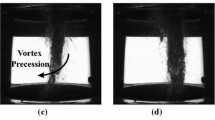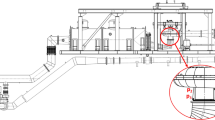Abstract
Francis turbines operating at part-load experience the development of a precessing cavitation vortex rope at the runner outlet, which acts as an excitation source for the hydraulic system. In case of resonance, the resulting pressure pulsations seriously compromise the stability of the machine and of the electrical grid to which it is connected. As such off-design conditions are increasingly required for the integration of unsteady renewable energy sources into the existing power system, an accurate assessment of the hydropower plant stability is crucial. However, the physical mechanisms driving this excitation source remain largely unclear. It is for instance essential to establish the link between the draft tube flow characteristics and the intensity of the excitation source. In this study, a two-component particle image velocimetry system is used to investigate the flow field at the runner outlet of a reduced-scale physical model of a Francis turbine. The discharge value is varied from 55 to 81 % of the value at the best efficiency point. A particular set-up is designed to guarantee a proper optical access across the complex geometry of the draft tube elbow. Based on phase-averaged velocity fields, the evolution of the vortex parameters with the discharge, such as the trajectory and the circulation, is determined for the first time. It is shown that the rise in the excitation source intensity is induced by an enlargement of the vortex trajectory and a simultaneous increase in the precession frequency, as well as the vortex circulation. Below a certain value of discharge, the structure of the vortex abruptly changes and loses its coherence, leading to a drastic reduction in the intensity of the induced excitation source.
















Similar content being viewed by others
References
Alligné S, Nicolet C, Tsujimoto Y, Avellan F (2014) Cavitation surge modelling in Francis turbine draft tube. J Hydraul Res 52(3):1–13
Bhagwat M, Ramasamy M (2012) Effect of tip vortex aperiodicity on measurement uncertainty. Exp Fluids 53(5):1191–1202
Brennen C, Acosta A (1976) Dynamic transfer function for a cavitating inducer. J Fluids Eng Trans ASME 98 Ser 1(2):182–191
Cala C, Fernandes E, Heitor M, Shtork S (2006) Coherent structures in unsteady swirling jet flow. Exp Fluids 40(2):267–276
Cassidy J, Falvey H (1970) Observations of unsteady flow arising after vortex breakdown. J Fluid Mech 41(pt 4):727–736
Couston M, Philibert R (1998) Partial load modelling of gaseous Francis turbine rope. Int J Hydropower Dams 1:146–158
Dörfler P (1982) System dynamics of the Francis turbine half load surge. In: Proceedings of the 11th IAHR symposium on operating problem of pump stations and powerplants, Amsterdam, Netherlands
Dreyer M, Decaix J, Münch-Alligné C, Farhat M (2014) Mind the gap: a new insight into the tip leakage vortex using stereo-PIV. Exp Fluids 55(11):1–13
Escudier M (1987) Confined vortices in flow machinery. Annu Rev Fluid Mech 19:27–52
Fanelli M (1989) Vortex rope in the draft tube of Francis turbines operating at partial load. A proposal for a mathematical model. J Hydraul Res 27(6):769–807
Favrel A, Landry C, Müller A, Yamamoto K, Avellan F (2014) Hydro-acoustic resonance behavior in presence of a precessing vortex rope: observation of a lock-in phenomenon at part load Francis turbine operation. IOP conference series: earth and environmental science, 22
Glas W, Forstner M, Kuhn K, Jaberg H (2000) Smoothing and statistical evaluation of laser Doppler velocimetry data of turbulent flows in rotating and reciprocating machinery. Exp Fluids 29(5):411–417. doi:10.1007/s003489900106
Graftieaux L, Michard M, Nathalie G (2001) Combining PIV, POD and vortex identification algorithms for the study of unsteady turbulent swirling flows. Meas Sci Technol 12(9):1422–1429
Griffiths A, Yazdabadi P, Syred N (1998) Alternate eddy shedding set up by the nonaxisymmetric recirculation zone at the exhaust of a cyclone dust separator. J Fluids Eng Trans ASME 120(1):193–199
Guggenberger M, Senn F, Schiffer J, Jaberg H, Gentner C, Sallaberger M, Widmer C (2014) Experimental investigation of the turbine instability of a pump-turbine during synchronization. IOP conference series: earth and environmental science, 22. doi:10.1088/1755-1315/22/3/032015
Gupta AK, Lilley DG, Syred N (1984) Swirl flows, vol 1. Abacus Press, UK
IEC Standards (1999) 60193: hydraulic turbines, storage pumps and pump-turbines - model acceptance tests, 2nd edn. International Commission
Iliescu M, Ciocan G, Avellan F (2008) Analysis of the cavitating draft tube vortex in a francis turbine using particle image velocimetry measurements in two-phase flow. J Fluids Eng Trans ASME 130(2):021105
Ingvorsen K, Meyer K, Walther J, Mayer S (2013) Turbulent swirling flow in a model of a uniflow-scavenged two-stroke engine. Exp Fluids 54(3):1–7
Jeong J, Hussain F (1995) On the identification of a vortex. J Fluid Mech 285:69–94
Kirschner O, Ruprecht A, Göde E, Riedelbauch S (2012) Experimental investigation of pressure fluctuations caused by a vortex rope in a draft tube. IOP conference series: earth and environmental science, 15
Kuibin P, Susan-Resiga R, Muntean S (2013) A model for precessing helical vortex in the turbine discharge cone. IOP conference series: earth and environmental science, 22
Landry C, Favrel A, Müller A, Nicolet C, Yamamoto K, Avellan F (2014) Experimental investigation of the local wave speed in a draft tube with cavitation vortex rope. IOP conference series: earth and environmental science, 22
Lucca-Negro O, O’Doherty T (2001) Vortex breakdown: a review. Prog Energy Combust Sci 27(4):431–481
Martinelli F, Cozzi F, Coghe A (2012) Phase-locked analysis of velocity fluctuations in a turbulent free swirling jet after vortex breakdown. Exp Fluids 53(2):437–449
Müller A, Dreyer M, Andreini N, Avellan F (2013) Draft tube discharge fluctuation during self-sustained pressure surge: fluorescent particle image velocimetry in two-phase flow. Exp Fluids 54(4):1–11
Müller A, Yamamoto K, Alligné S, Yonezawa K, Tsujimoto Y, Avellan F (2016) Measurement of the self-oscillating vortex rope dynamics for hydroacoustic stability analysis. ASME J Fluids Eng 138(2). doi:10.1115/1.4031778
Nishi M, Liu S (2013) An outlook on the draft-tube-surge study. Int J Fluid Mach Syst 6(1):33–48
Nishi M, Matsunaga S, Kubota T, Senoo Y (1982) Study on swirl flow and surge in an elbow type draft tube. In: Proceedings of the 10th IAHR symposium, Tokyo, Japan, vol 1, pp 557–568
Rheingans W (1940) Power swings in hydroelectric power plants. Trans ASME 62:171–184
Susan-Resiga R, Ciocan G, Anton I, Avellan F (2006) Analysis of the swirling flow downstream a Francis turbine runner. J Fluids Eng Trans ASME 128(1):177–189
Syred N (2006) A review of oscillation mechanisms and the role of the precessing vortex core (PVC) in swirl combustion systems. Prog Energy Combust Sci 32(2):93–161
Takamura H, Ebara S, Hashizume H, Aizawa K, Yamano H (2012) Flow visualization and frequency characteristics of velocity fluctuations of complex turbulent flow in a short elbow piping under high reynolds number condition. J Fluids Eng Trans ASME 134(10):101201
Widmer C, Staubli T, Lederberger N (2011) Unstable characteristics and rotating stall in turbine brake operation of pump-turbines. J Fluids Eng Trans ASME 133(4):041101
Acknowledgments
The research leading to the results published in this paper is part of the HYPERBOLE Research Project, granted by the European Commission (ERC/FP7-ENERGY-2013-1-Grant 608532). The authors would also like to thank BC Hydro for making available the reduced-scale model, in particular Danny Burggraeve and Jacob Iosfin. Moreover, the authors would like to acknowledge the commitment of the Laboratory for Hydraulic Machines’ technical staff, especially Georges Crittin, Maxime Raton, Victor Rivas, Alain Renaud, and Vincent Berruex.
Author information
Authors and Affiliations
Corresponding author
Rights and permissions
About this article
Cite this article
Favrel, A., Müller, A., Landry, C. et al. Study of the vortex-induced pressure excitation source in a Francis turbine draft tube by particle image velocimetry. Exp Fluids 56, 215 (2015). https://doi.org/10.1007/s00348-015-2085-5
Received:
Accepted:
Published:
DOI: https://doi.org/10.1007/s00348-015-2085-5




